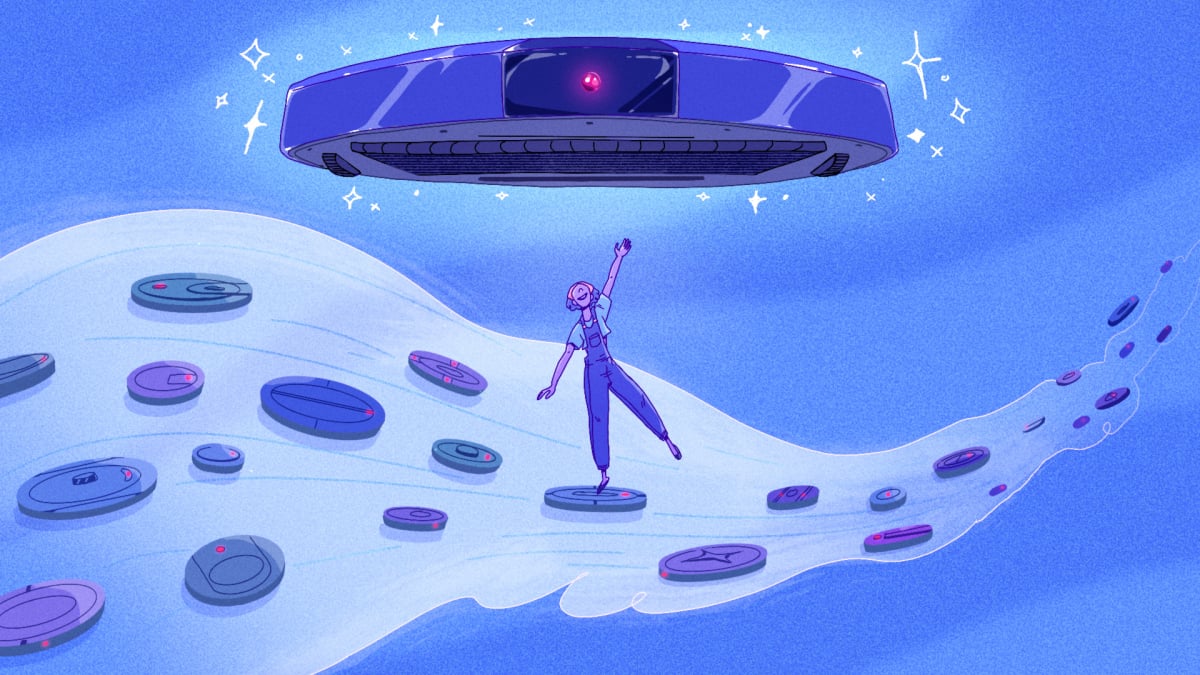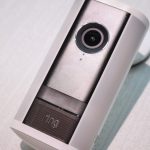
I found the best robot vacuums for every floor, budget, and level of laziness
Cross one chore off your to-do list for good.
By
Leah Stodart
Leah Stodart
Senior Shopping Reporter
Leah Stodart is a Philadelphia-based Senior Shopping Reporter at Mashable where she covers and tests essential home tech like vacuums and TVs, plus eco-friendly hacks. Her ever-evolving experience in these categories comes in clutch when making recommendations on how to spend your money during shopping holidays like Black Friday, which Leah has been covering for Mashable since 2017.
Read Full Bio
on October 18, 2025
Share on Facebook
Share on Twitter
Share on Flipboard
All products featured here are independently selected by our editors and writers. If you buy something through links on our site, Mashable may earn an affiliate commission.
Overview
Table of Contents
There’s definitely something to be said for the crisp handheld control of a powerful cordless stick vacuum. But if you don’t consider cleaning cathartic, the best robot vacuums can cross that chore off your to-do list for good.
And after testing more than 25 robot vacuums on my own personal floors (my apartment is very clean), I can confidently curate a handful of robot vacuum recommendations that’ll make your life easier — and fit your budget.
I test new robot vacuums on a regular basis and compare them to the top performers from previous months, with all my evaluations taking place in my own home on various rugs, tile, and hardwood floors. As I test each robot vacuum, I keep notes on their overall suction power, scrubbing efficacy (if it’s a robot vacuum and mop combo), pet hair pickup, the convenience of their automatic emptying and self-washing mopping pads, accuracy of smart mapping and small obstacle avoidance, and the overall user experience. But the final boss here is cost efficiency — I’ll be the first one to point out when a cheap robot vacuum actually works well for the price, or when a high-end robot vacuum is actually worth the splurge or not.
Throughout my continuous at-home testing, I found the best robot vacuum to buy for every home and budget in the last few months of 2025.
I’ve been testing robot vacuums for Mashable since 2019 — most recently in a three-bedroom, two-cat apartment.
All of these vacuums were tested for at least four weeks. I put them through a series of standardized tests that cover the four main pillars of robot vacuum competence, while also considering overall bang for your buck.
Each vacuum tackles various spills, debris, levels of pet hair, and floor types. I also tested hybrid vacuum and mop combo models on various stains and spills.
I keep tabs on navigational accuracy when it comes to smart mapping my home, finding specific rooms and zones, and identifying small obstacles using LiDAR or cameras.
Your new robot vacuum should be a polite houseguest. I make sure each vacuum isn’t too loud, an eyesore, or generally a pain to use.
Many robot vacuums automate their own dust bin emptying, mopping pad washing, and more — the more self-sufficient they are, the better.
Our Pick
The Good & The Bad
Market-leading 30,000 Pa suction power
Suction boost mode for large particles like kibble and litter
Sturdy roller mop rinses itself in real time
Cleaning and self-emptying are pretty quiet
Can scale thresholds of up to 3.15 inches
Livestream pet camera
Corner and edge debris pickup is hit or miss
Pretty chunky with LiDAR tower raised
Roller mop doesn’t extend far enough into corners
Can’t trust it to not eat furry rugs
Our review
Read my initial review of the Dreame Aqua10 Ultra Roller.
Who it’s for
The Dreame Aqua10 Ultra Roller is the powerhouse robot vacuum to splurge on for heavy-duty upkeep of frequent wet and dry spills. It would flourish in busy households with multiple kids or pets, complex furniture arrangements, or multiple floor types, including steep thresholds in doorways or any shallow sunken rooms separated by a step.
It’s not necessarily as detail-oriented when edge cleaning as the excellent Roborock Saros 10R, but it is the most likely robot vacuum to come to the rescue for large in-the-moment messes.
Why we picked this
The Dreame Aqua10 Ultra Roller is the new robot vacuum to beat. Its Sept. 2025 release set the stakes quite high for the new wave of robot vacuums that’ll be debuted at CES 2026 in January, and being able to climb stairs thresholds up to 3.15 inches tall is hardly its preeminent edge.
The more important number here is actually 30,000, as in 30,000 Pa of suction power — a new market high, and a daunting 8,000 Pa stronger than Roborock’s most powerful robot vacuums. I can attest to its tenacity after it recorded exceptional pickup rates on debris obstacle courses in my apartment, from crystal cat litter on a tile floor, crushed crackers and rice on the hardwood kitchen floor, and mega clumps of cat hair on a medium pile rug. I still think it’s wise to toggle double cleaning passes (instead of just one) in the app, as the side brush does have a tendency to nudge loose debris out of the cleaning path.
If you’ve been disappointed by lazy or streaky mopping from a cheaper 2-in-1 robot vacuum and mop in the past, I think a roller mop robot vacuum should be your next move. Dreame calls it FluffRoll tech: sturdy force pressing the ultra-soft fibers onto the floor and into cracks or grout to scrub at stubborn dried grime from heavy shoe or paw traffic. The texture and size of the roller just feels more absorbent than thinner pads I’ve seen in other hybrid robot vacuums — in my apartment, the Aqua10 Ultra Roller efficiently wiped up a variety of spill consistencies, from wine and strawberry daiquiri mix, to buffalo sauce and ranch dressing, to a thick pudge of icing after the devastating fall of a cupcake.
I also think the wet roller actually helps this Dreame to vacuum better, lapping up finer particles like protein powder or litter dust better than dry suction alone. The roller rinses itself while it’s mopping to prevent spreading the mess around, and mops with a legit cleaning solution, which is helpfully included in the box.
The Dreame Aqua10 Ultra Roller has brains behind the brawn. The livestream pet camera is becoming a given with all new premium robot vacuum releases, and this is the most accurate phone charger avoidance tech I’ve seen in a long time.
Details
The Good & The Bad
Barely three inches tall
Dual spinning mopping pads scrub corners and edges closely
Relatively quiet when cleaning, self-emptying, and mop washing
Brush rolls really are anti-tangle, for once
Barely ever gets lost
Auto-dispenses detergent
Livestream pet camera is actually pretty useful
Phone charger avoidance still isn’t perfect
Pet hair pickup on low-pile carpet could be better
Dock’s slightly curved top is annoying
Takes forever to mop
I wish it came in white like the Saros 10
Our review
Read my full review of the Roborock Saros 10R.
Who it’s for
The Roborock Saros 10R is a worthwhile investment for people who are picky about their floors — the type who considers a floor dirty after a mere day or two of dust accumulation, or a singular crumb under the counter. or heavy foot traffic or paw traffic. If your home is fully carpeted aside from the kitchen and a bathroom, it’s probably overkill.
With the Saros 10R, you get literal wall-to-wall cleaning and true barefoot-ready sanitation that’s often hit or miss with cheaper robot vaucums.
The Saros 10R
Why we picked this
You probably wouldn’t initially peg one of the thinnest robot vacuums on the market as one of the most powerful. But Roborock somehow squeezed an incredible amount of power under the slim hood of the Saros 10R, and it ended up being the most well-rounded robot vacuum that I’ve ever tested and the best robot vacuum to buy right now. Not for nothing, but of the best self-emptying robot vacuums I’ve tried at home, this dock is one of the most stylish.
Its 20,000 Pa of suction power nears the strongest you can get in 2025, and doubles the 10,000 Pa that the Roborock Qrevo Master, my top pick from 2024, had. While it didn’t fully ace pulling pet hair off of every pile of rug in my home, it still overall had a great track record with debris from protein powder, to kitty litter, to long human hairs, to whole goldfish crackers. Even on Max mode, it’s not very loud, either.
But the Saros 10R really shone during mopping. I firmly back the dual spinning mopping pad setup like this one over the single flat pad design — I always feel like the double movement provides more opportunity to fully wipe up spills and scrub at stains. One of those mops is hinged and can swing out a few inches past the vac’s circular body, allowing the Saros 10R to get more detailed along wall edges and in corners than most hybrid robovacs can. Imagine the satisfaction of watching the Saros 10R squeeze into a low-clearance sticky spot, like under the fridge, and then diligently mop that crevice. This flexible mopping pad design is also the main reason why I’d recommend the Saros 10R over the Saros 10, whose singular mopping pad was more likely to smear spills in my testing.
Finishing touches include small obstacle avoidance that was about 85 percent reliable around cords, laundry, and shoes in my home, as well as a livestream pet camera that I actually used a lot when I wasn’t home.
Details
The Good & The Bad
Frequently on sale for under $400
Shockingly affordable for a robot and stick vacuum combo
Suction power of both vacuums is powerful for the price
75 day self-empty dust capacity
Room by room smart mapping is quite accurate
Dock is very compact
Doesn’t mop
A bit loud
Exposed motor isn’t the most aesthetically appealing design
Our review
Read my review of the Eufy E20 3-in-1.
Who it’s for
The percentage of homes that would benefit from having both a robot vacuum and a manual stick vacuum is probably 100 percent. In a perfect world, right? If you don’t have the space, budget, or patience for that, the Eufy E20 3-in-1 is a really strategic way to maximize a mid-range budget. The E20 would have serious daily usability if your idea of a clean home goes past the floors to crevices like windowsills, car seats, staircases, or the pit of despair between couch cushions.
Why we like it
In a sea of $1,500+ vacuums, Eufy was genius to take the “bang for your buck” approach with its CES 2025 contender. At $649.99, the Eufy E20 3-in-1 isn’t all that steep for a self-emptying, smart mapping robot vacuum, let alone the bonus cordless vacuum it brings along. Here, 3-in-1 refers to the robot vacuum, cordless stick vacuum, and handheld modes. Switching between these modes just involves pulling the motor out of the robot vacuum body and clicking it onto one of the included attachments.
The Eufy E20 definitely isn’t the most powerful robot vacuum I’ve tested, nor is it as powerful as my favorite Dyson vacuum, which I should note has an identical price tag. We already know that its real power lies in its range, but for the value, its robotic and handheld cleaning capabilities would actually suffice for any casual cleaner. At 8,000 Pa, it vacuums with the same amount of suction power as last year’s Eufy X10 Pro Omni, which also impressed me during testing. Its pickup rate of fine debris along edges and long hairs on rugs could be better, but the E20 reliably took care of all visible crumbs and loose tufts of pet hair on most rugs, hardwood, and tile.
While the Eufy E20 can avoid items like toys over 15 millimeters or pet food bowls, its obstacle avoidance doesn’t extend to flatter items like cords or socks. Its navigation to specific rooms and zones, however, was nearly perfect in my apartment. It surveyed the three bedrooms and bathrooms extremely accurately on the first try, and after I added an extra border or two, the E20 reliably made its way to selected spots on a daily basis — and without getting stuck on a bath mat or under a bed.
Details
The Good & The Bad
Occasionally on sale for under $400
18,000 Pa suction power is wicked at any price point
Deals with dust for 60+ days without an auto-empty dock
Reliable small obstacle avoidance
Live stream pet camera is so rare at this price
Smart mapping is incredibly accurate and detailed
Can be stored under furniture
Physical design isn’t exactly chic
Mopping is pretty basic
Our review
Read my review of the 3i G10+.
Who it’s for
If you’re set on spending less than $500 on a robot vacuum, there are few reasons to not go with the 3i G10+. Between its ability to get around in small, cluttered spaces and its dust-compacting, space-saving design, the 3i G10+ would particularly be a great pick for apartments.
This niche, inexpensive pick also eclipses any other robot vacuum under $500 in the pet hair department — and even has stronger suction power than many premium robot vacuums. While it’d be a great pick for homes with a lot of carpeting or rugs, it can be ruled out for large homes with lots of hard floors and heavy-duty mopping needs.
Why we picked this
This is the first robot vacuum I’ve ever tested from 3i, and I already know it’s going to be one of my most recommended robot vacuums of the year. While its dust-compacting element is cool because it saves you the space a self-empty dock would take up, it’s hardly the G10+’s only monumental feature.
For such an inexpensive robot vacuum I was thoroughly impressed by the G10+’s perceptive navigation around my apartment. Its initial mapping run of the rooms was almost 100% accurate —it even recognized beds, credenzas, and toilets all on its own, and automatically remembered where all of the rugs were. The 3i G10+ is also the incredibly rare budget option with small obstacle avoidance that can steer clear of cords or socks, plus pet waste (I tested this with fake brown sugar). But small obstacle avoidance isn’t the only high-end feature 3i squeezed in here here — there’s also a livestream pet camera. That was firmly a $1,000+ robot vacuum feature until now.
All of that brainpower isn’t just fluff, either. The G10+ is a beast at cleaning. Its 18,000 Pa of suction power is super high for this price range, and you can tell that the G10+ is working hard as it moves extra meticulously when carpet is sensed, or during zone cleaning.
Details
The Good & The Bad
Frequently on sale for $379.99
Very quiet, especially when self-emptying
Five-digit suction power is rare in this price range
Affordable small obstacle avoidance for laundry and pet waste
Sonic mopping actually scrubs with pressure
LiDAR smart mapping is quick, accurate, and color-coded
Mopping is thorough, but pad gets gross quickly
Dock is compact, but robot itself isn’t very slim
Skimps on edge mopping
Who it’s for
This Roborock robot vacuum is ideal for those who don’t want to spend much more than $500, but who also don’t want to settle for the most basic cleaning possible. This 2025 entry-level model is the rare cheap robot vacuum and mop combo with legitimate pressurized scrubbing — a nice upgrade for hardwood floors or entryways with high foot (or paw) traffic. Its self-empty dock barely takes up two feet of floor space, and its noise level is quite low, making it a great robot vacuum for small spaces.
Why we picked this
Unlike iRobot, Roborock has always been a brand that gives ample attention to the budget-friendly half of its product line. So it’s saying something that I think the Roborock Q10 S5+ is the best bang for your buck near $500 that Roborock has whipped up in a long time. It has reliably completed all missions in my apartment for weeks, and isn’t nearly as obnoxious when self-emptying as most other robot vacuums I’ve tested — it barely reaches 70 decibels, which isn’t much louder than competitors while they’re just cleaning.
The Roborock Q8 Max+ has probably popped up in your research for the best robot vacuum and mop combo on a budget. Roborock itself says that the Q10 S5+ is the direct successor of that model, and there’s no reason not to upgrade: The Q10 S5+ nearly doubles the suction power — 10,000 Pa versus the Q8 Max+’s 5,500 Pa — which makes it just as powerful as the high-end Roborock Qrevo Master that I loved in 2024. While I do prefer the spinning mopping pad design found on more premium Roborocks, the forceful vibrations of the Q10 S5+’s singular mopping pad provide more thorough scrubbing than many cheap 2-in-1 vacuums. The Q10 S5+ successfully wiped up a variety of spills and splatters in my kitchen and near the cat bowls, though it doesn’t mop very close to edges.
Roborock has consistently shown me the most user-friendly app experience. The Q10 S5+ supports the same color-coded home map with the same straightforward room and zone cleaning options, and never once got lost in my apartment when navigating to a particular spot. Unlike the Shark Matrix Plus 2-in-1 (which was previously in this spot on our list), the Q10 S5+ automatically lifts the mop when carpets and rugs are detected. Small obstacle avoidance is also a bonus at this price point.
Details
The Good & The Bad
Frequently on sale for under $300
Better suction power than the Roomba i5 or Roomba 694
LiDAR mapping correctly identifies specific rooms
Four versions mix and match mopping and automatic emptying
Doesn’t always smoothly get over rugs
No small obstacle avoidance technology
Not enough suction power for shedding from multiple pets
Who it’s for
If you absolutely must have the iRobot name under your roof, the Roomba 105 series vacuums are iRobot’s most advanced and fairly-priced entry-level robot vacuums to date. They’d be ideal for the crowd who is totally fine with settling for a not-amazing-but-decent clean if it affordably lightens their chore load. It’d be a fine addition to an apartment or small space with low foot traffic and relatively simple layouts.
It’s also nice that you can customize your choice to the features you need in your house — and how much you want to spend. There are four versions of the Roomba 105: a standalone mopping and non-mopping version, and a self-emptying mopping and non-mopping version. They all have huge discounts quite often, dropping both standalone models below $200 and both self-emptying models below $300.
Why we picked this
To be real, any random Roomba you could pick out is probably being upstaged by a different brand’s robot vacuum with the same price tag. But if you insist on trying a Roomba, the 2025 Roomba 105 series vacuums definitely offer better bang for your buck over any of the low-budget Roombas.
The most impactful upgrade from the i5 to the 105 lies in suction power: The Roomba 105 offers 60 times the suction of 600 series Roombas like the Roomba 694 or Roomba 675, while the Roomba i5 offers just 10 times the power of the 600 series. This translates to 7,000 Pa in suction power for the 105 (a metric that iRobot hadn’t used until this 2025 round of Roombas.) On my apartment’s hard floors, the 105 had a commendable track record for the price — it sucked up most tracked kitty litter and spilled protein powder, and grabbed all but one or two heavy pieces of dry cat food. On rugs, most loose crumbs and visible fuzzies were taken care of, though matted down cat fur required a second pass from a stick vacuum.
iRobot also finally shifted to LiDAR-based smart mapping with its 2025 Roombas, which ultimately just means faster, more precise room mapping. The Roomba 105 successfully made it to the selected rooms and zones in my apartment 95 percent of the time, despite the new Roomba Home app being significantly more basic than the old one.
Details
The Good & The Bad
Frequently on sale for under $700
8,000 Pa suction power wows in this price range
Affordable AI obstacle avoidance
Automatic water refill and mop pad washing/drying
Loud automatic emptying
Mistakes small rugs for obstacles
Still only has a single roller brush
Our review
Read my full review of the Eufy X10 Pro Omni.
Who it’s for
The Eufy X10 Pro Omni is a stellar find for shoppers who can spend more than a few hundred bucks but who still draw the line at $1,000. With small obstacle avoidance and a self-washing and drying mopping system, this Eufy offers more bang for your buck than the similarly priced Roomba Combo j7+ or Roborock Q8 Max+. This particular Eufy robovac also has some of the best battery life on the market (even on its highest suction setting), making it an even easier choice for homes with lots of square footage or multiple stories.
Of all the X10 Pro Omni’s advanced features, the small obstacle avoidance can’t be understated, especially in homes that are, let’s say, well lived in. If you could bet money that there’s a rogue sock, kid or pet toy, or phone charger on the ground at any given moment (it’s the mountain of crap shoved under my bed for me), you’ll appreciate the AI-powered small obstacle avoidance, which lets you confidently run the robot vac when you’re not home to tidy up first.
Why we picked this
Eufy’s most elaborate robot vacuum (it’s the brand’s first self-emptying hybrid that self-refills the water tank and self-washes and dries the mopping pads) was also somehow the most affordable robot vacuum that debuted at CES 2024. That plus small obstacle avoidance are features we usually see in only the priciest vacs in the competition, so the fact that the X10 Pro Omni’s resumé has both is seriously impressive.
Props to Eufy for not skimping on wet or dry floor cleaning here. Its official suction power ranking of 8,000 Pa is beastly on paper and proved proficient IRL on messes like spilled dry rice on both medium and flat piles. For wet or sticky messes, it’s a rare sub-$800 model with dual spinning mopping pads to actually scrub more than gloss.
Details
Other robot vacuums I’ve tested recentlyI tested several other top robot vacuums in the past that didn’t make the most recent cut for this list. Some, like the Roborock S8 MaxV Ultra, Roborock Qrevo Master, Narwal Freo X Ultra, and various versions of the Roomba j7 were my top recommendations at one point, but have since been overshadowed by newer, more powerful models that are a better bang for your buck.
I’ve also tested some 2025 robot vacuum releases that were OK, but ultimately aren’t a top pick for me. The Dreame X50 Ultra grabbed attention during its CES 2025 debut for its ability to “climb,” though the fine print is that it can’t scale thresholds taller than 6 millimeters (about 2.36 inches). A slew of new Dreame robot vacuums are slated to come out in fall 2025, among them a model with improved climbing abilities and a model whose self-empty dock can hold three sets of mopping pads. I’ll be getting my hands on these as soon as possible and updating my top picks for this list accordingly.
Frequently Asked Questions
Though some Roombas are really good robot vacuums, they’re far from the only good robot vacuums.
iRobot dominated the robot vacuum realm from the early 2000s up until a few years ago, so it’s no surprise that much of the general public forgets that “Roomba” isn’t simply a generic term for any robotic vacuum cleaner.
But Roombas aren’t in a league of their own anymore. I mean, you can’t even Google “Roomba” without seeing a related question in the search results, wondering if Shark or Roomba is better. (In general, we prefer Shark.) I’m also here to put some respect on names like Roborock and Eufy — they’re continuously releasing new contenders that are often a better value than Roombas in the same price range.
The robot vacuum market is crowded, but there are several feature-related guidelines to keep in mind when shopping to ensure a robot vacuum is worth buying. Smart mapping is a non-negotiable at this point — the ability to clean specific rooms and spots on command can make or break how much you’ll trust your vacuum to do a thorough job. You’ll want to aim for at least 6,000 Pa, though suction power between 12,000 and 22,000 Pa will work the best on pet hair. Whether or not you want a robot vacuum that mops depends on your home’s floor type, but a vast majority of the models released nowadays are robot vacuum and mop combos, anyway.
Because robot vacuums are sweeping your home more often than you would manually, they’ll fill up pretty fast. Self-emptying robot vacuums are worth the convenience in almost every situation. Many of the more elevated auto-empty docks can also self-wash and self-dry your 2-in-1 vacuum’s mopping pads. If you have a large space and don’t feel like tossing the mop in the laundry every day, definitely consider one of these elevated models.
Most robot vacuum run times range between 90 and 180 minutes, which translates to about 500 and 2,600 square feet covered on one charge. Some ultra-efficient models can clock over 200 minutes on one charge, which would only really matter in homes exceeding 3,000 square feet. Larger spaces or homes with multiple stories obviously require more time to clean, and how much you prioritize battery life depends on how annoyed you’ll be if your robot vac has to take a time out during its queue to charge.
Sadly, no, the Dyson 360 Vis Nav doesn’t live up to the hype. Dyson claims that its first robot vacuum in almost a decade has twice the suction power of any robot vacuum on the market. While vacuuming was decent in testing done at Senior Shopping Reporter Leah Stodart’s home, she wasn’t as blown away by the results as she expected — and was full-on disappointed by the 360 Vis Nav’s edge cleaning, despite Dyson asserting that the 360 Vis Nav uses a special side duct to reach into corners and along walls better than competitors.
And without a self-emptying dock, mopping capabilities, or small obstacle sensors that detect cords or pet waste (an absolute must in this price range), the Dyson 360 Vis Nav isn’t worth $1,199.99. There are more reliable options that have a much more robust list of features, whether you’re down to spend over a grand or not.
Although, Dyson recently announced a new robot vacuum that does have premium features like mopping, self-emptying, and obstacle avoidance, so we’ll see if that one is worth buying once we get our hands on it to test.
Leah Stodart is a Philadelphia-based Senior Shopping Reporter at Mashable where she covers and tests essential home tech like vacuums and TVs, plus eco-friendly hacks. Her ever-evolving experience in these categories comes in clutch when making recommendations on how to spend your money during shopping holidays like Black Friday, which Leah has been covering for Mashable since 2017.











